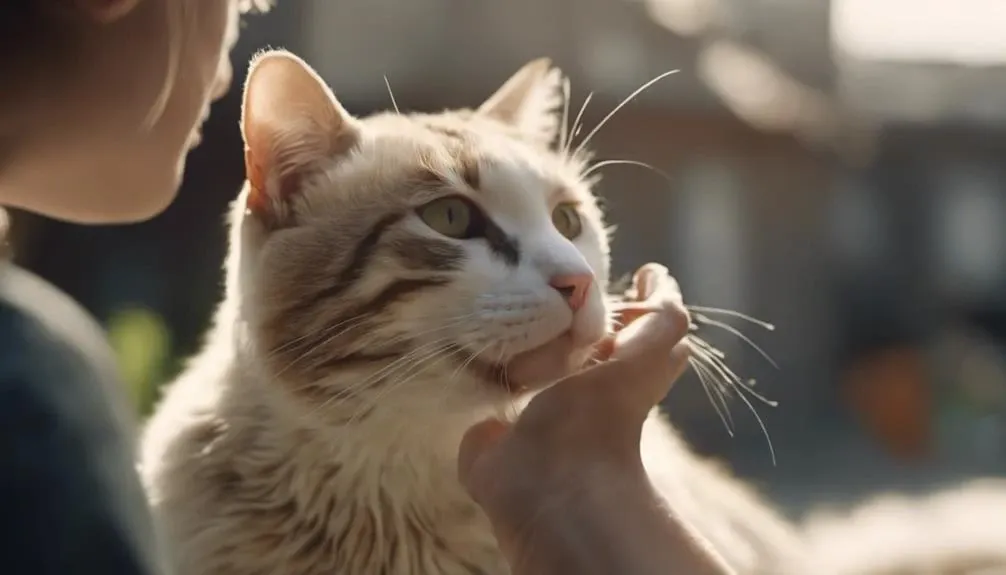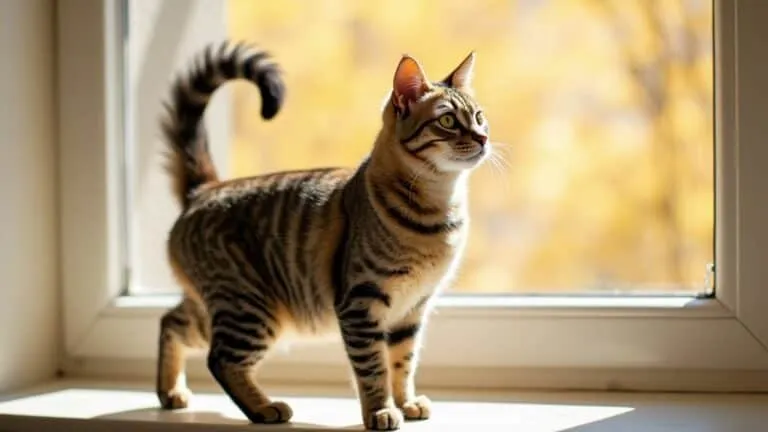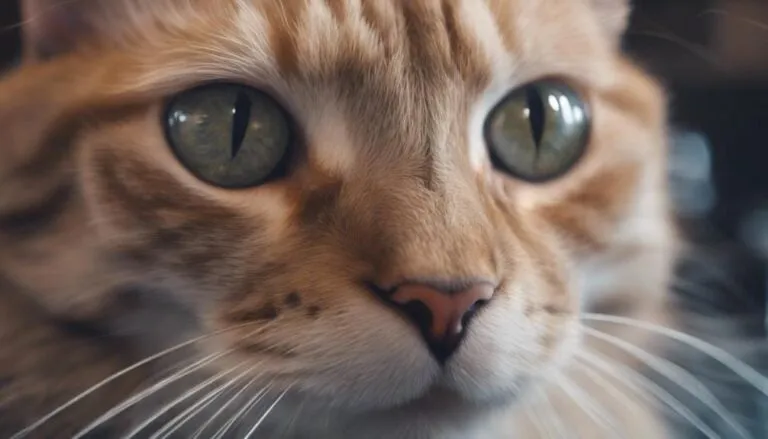The Best Fluffy Pancakes recipe you will fall in love with. Full of tips and tricks to help you make the best pancakes.

If you're wondering if there's anything you can do to help your cat stop sneezing, rest assured, there are steps you can take to provide relief.
From simple environmental adjustments to understanding potential underlying causes, addressing your cat's sneezing can lead to improved well-being and comfort for your feline companion.
By exploring proven strategies and practical tips, you can support your cat's health and possibly uncover surprising solutions to this common issue.
Key Takeaways
- Address underlying causes like infections or allergies.
- Provide treatments like antibiotics or decongestants.
- Use home remedies such as saline nose drops.
- Monitor your cat closely for signs of improvement or distress.
Common Causes of Cat Sneezing
If your cat is constantly sneezing, it's essential to understand the common causes that could be behind this behavior. Cat sneezing can be a result of various issues, including upper respiratory infections like herpesvirus and calicivirus. Inhaled irritants and allergens are also common triggers for sneezing in cats. Additionally, dental problems such as gingivitis or periodontitis may lead to sneezing episodes. Another potential cause could be the blockage of nasal passages by polyps, tumors, or foreign objects, resulting in sneezing and nasal discharge in cats.
Identifying the underlying cause of your cat's sneezing is crucial for appropriate treatment and management. If you notice persistent sneezing or other concerning symptoms, it's best to consult a vet for a thorough evaluation. A vet can perform necessary tests to determine the root cause of the sneezing and recommend the most suitable course of action to help your feline companion feel better.
Symptoms of Cat Sneezing
If your cat is sneezing, pay attention to common symptoms like nasal or eye discharge, and occasional coughing.
Red or swollen eyes paired with sneezing could signal underlying health concerns.
Keep an eye out for signs of nasal congestion and changes in behavior that may indicate your cat needs veterinary care.
Common Sneezing Triggers
When identifying common sneezing triggers in cats, it's essential to recognize that allergies, infections, and inhaled irritants can often be the culprits. Cats may experience nasal discharge, coughing, and pawing at the face when exposed to triggers like dust, pollen, strong odors, or environmental toxins.
Feline Herpes virus and respiratory infections are also common causes of sneezing in cats. Dental diseases, such as gingivitis or tooth resorption, can lead to sneezing as well.
Identifying and addressing the specific trigger for your cat's sneezing is crucial in providing effective treatment. By minimizing exposure to these triggers, you can help alleviate your cat's symptoms and improve their overall well-being.
Treatment Options
To address the symptoms of cat sneezing, treatment options encompass a range of approaches tailored to alleviate your feline companion's discomfort and improve their respiratory health. Here are some effective treatment options for cat sneezing:
- Antibiotics: Prescribed for upper respiratory infections causing cat sneezing.
- Decongestants: Help reduce nasal congestion and improve breathing in cats with sneezing.
- Antihistamines: Recommended to manage allergies contributing to cat sneezing.
- Surgery: Required to remove polyps, tumors, or foreign objects causing cat sneezing and nasal discharge.
These treatments aim to address the underlying causes of cat sneezing, providing relief and enhancing your cat's well-being.
Home Remedies for Cat Sneezing
You may find relief for your cat's sneezing through simple home remedies. Saline nose drops can help thin mucus, while increasing humidity in your home can soothe irritated nasal passages.
Switching to low-dust cat litter and using air purifiers may also reduce airborne irritants triggering your cat's sneezing.
Natural Remedies Effectiveness
Utilizing natural remedies, such as saline nose drops, can effectively assist in thinning mucus and alleviating sneezing in cats. To further combat cat sneezing, consider increasing humidity levels in your home to reduce dry nasal passages.
Additionally, minimizing airborne irritants by maintaining a clean environment can help decrease sneezing triggers. Switching to low-dust cat litter can also play a significant role in reducing respiratory irritation and the frequency of cat sneezing episodes.
Safety of Home Treatments
When considering home remedies for your cat's sneezing, it's important to prioritize safety and effectiveness in alleviating your furry friend's discomfort. Home treatments like increasing humidity and using saline nose drops can help ease cats sneezing.
Ensure a clean environment by reducing airborne irritants through thorough cleaning and switching to low-dust cat litter to minimize respiratory issues. Providing a stress-free environment can also prevent triggers that lead to cat sneezing.
It's crucial to remember that these remedies should complement veterinary care to effectively address your cat's sneezing. By incorporating these safe home remedies, you can help your cat breathe easier and enjoy a happier, healthier life.
Allergy Management for Cats
To effectively manage your cat's allergies, it's crucial to identify and eliminate potential allergens in its environment. Here are some essential steps to help you in allergy management for your feline friend:
- Identify Allergens: Determine what triggers your cat's allergies, such as dust, pollen, or certain foods, and take steps to minimize exposure.
- Consult a Veterinarian: Seek guidance from a veterinarian to assess if your cat needs allergy testing or medication to manage symptoms like nasal discharge and sneezing effectively.
- Maintain Cleanliness: Keep your cat's living space clean by vacuuming regularly, using air purifiers, and opting for hypoallergenic bedding and cat products to reduce allergen buildup.
- Observe and Adjust: Monitor how your cat responds to different environments and make necessary adjustments to create a safer, allergen-free space for your beloved pet.
Recognizing When to Seek Vet Care
If your cat exhibits persistent sneezing along with nasal discharge lasting more than a few days, seeking evaluation from a veterinarian is crucial. Increased frequency of sneezing and changes in the color or consistency of nasal discharge can also indicate the need for professional veterinary care. Look out for behavioral signs like rubbing the nose or pawing at the face, as well as noisy or raspy breathing, as these suggest a vet examination is necessary.
In more severe cases, if your cat shows signs of respiratory distress or discomfort, immediate veterinary attention is crucial to address any underlying health issues promptly. Monitoring your cat's sneezing patterns and seeking vet care promptly can help diagnose and treat potential causes of your cat's sneezing episodes effectively. Remember, early intervention can prevent conditions from worsening, ensuring your cat's health and well-being.
Treating Bacterial Infections in Cats
Upon noticing symptoms of bacterial infections in your cat, such as sneezing, nasal discharge, or respiratory issues, it's crucial to seek prompt veterinary care to initiate appropriate treatment with antibiotics. Bacterial infections in cats can be caused by pathogens like Bordetella, Chlamydia, and Mycoplasma, leading to discomfort and health complications if left untreated.
To address these infections effectively, here's what you should consider:
- Veterinary Consultation: Schedule a visit with your veterinarian as soon as symptoms arise to determine the best course of treatment.
- Antibiotic Therapy: Administer antibiotics as prescribed by the veterinarian to combat the specific bacterial strain causing the infection.
- Targeted Treatment: Diagnostic tests, such as cultures, can help identify the exact bacteria involved, allowing for more targeted and effective treatment.
- Timely Intervention: Prompt treatment not only alleviates your cat's symptoms but also helps prevent the infection from progressing and promotes a faster recovery. Remember, early intervention is key to ensuring your cat's health and well-being.
Preventing Cat Dental Issues
Regular dental check-ups play a vital role in preventing dental issues in cats. By staying proactive in your feline friend's oral health, you can help avoid potential problems down the line. Brushing your cat's teeth regularly, providing dental treats and toys, and feeding a balanced diet all contribute to maintaining good dental hygiene. Early detection of any dental issues is key to preventing discomfort for your cat and avoiding more serious complications. Here is a table summarizing key points to help you prevent dental problems in your cat:
| Preventive Measures | Benefits |
|---|---|
| Regular dental check-ups | Early detection of dental issues |
| Brushing cat's teeth regularly | Reduces the risk of dental problems |
| Providing dental treats and toys | Promotes oral health |
| Feeding a balanced diet | Contributes to good dental health |
Taking these steps can help ensure your cat's dental health and overall well-being.
Ensuring Cat Comfort During Sneezing
To ensure your cat's comfort during sneezing, creating a warm and allergen-free environment is crucial for alleviating any discomfort they may experience. Here are some tips to help keep your feline friend comfortable during sneezing episodes:
- Indoor Environment: Keep your cat indoors to reduce exposure to allergens and foreign bodies that can trigger sneezing and respiratory issues.
- Moisture in the Air: Use a humidifier or vaporizer to add moisture to the air, helping to ease congestion and promote easier breathing for your cat.
- Close Monitoring: Watch your cat closely for any worsening symptoms during sneezing episodes, providing gentle care to keep them comfortable.
- Avoid Irritants: Refrain from using strong-smelling products or essential oils around your cat, as these can exacerbate sneezing and respiratory problems.
Monitoring Cat's Recovery Progress
When monitoring your cat's recovery progress from sneezing episodes, observe their sneezing frequency and intensity daily to assess improvement or worsening. Keeping track of how often and how intensely your cat sneezes can help you gauge the effectiveness of the treatment and whether any adjustments are needed. Additionally, note any changes in appetite, energy levels, or signs of respiratory distress. These observations can provide valuable information for your veterinarian to evaluate your cat's overall health.
| Category | Description |
|---|---|
| Sneezing Frequency | Note the number of sneezing episodes per day. |
| Changes in Appetite | Monitor any changes in your cat's eating habits. |
| Respiratory Distress | Watch for signs of difficulty breathing or wheezing. |
| Prescribed Medications | Record the dosage and effectiveness of medications. |
Remember to communicate regularly with your vet, sharing any additional symptoms or concerns. This collaborative approach will help track your cat's progress and ensure the most appropriate care for their recovery.
Frequently Asked Questions
What Should I Do if My Cat Keeps Sneezing?
If your cat keeps sneezing, check for allergy triggers, schedule a veterinary visit, try home remedies for respiratory health, improve grooming habits, maintain a clean indoor environment, and manage stress. Your furry friend's well-being matters.
How Do You Help Cat With a Cold That Is Sneezing?
To help your cat with a cold that is sneezing, try home remedies like warm compresses and steam therapy. Ensure hydration, visit a vet if needed, consider allergy testing, and make necessary diet changes for your cat's well-being.
How Do You Make a Cat Sneeze to Clear Your Nose?
To clear your nose, avoid inducing sneezing in your cat. It can harm and stress them. Address your own nasal issues with remedies like air purifiers, allergy relief, and managing pet dander without involving your cat's health.
How Do You Flush a Cat's Nose?
To flush a cat's nose, use a saline solution designed for cats. Hold your pet securely, tilt its head up, and spray the saline into each nostril. Let your cat sneeze or shake out the solution. Repeat as needed for allergy relief and nasal congestion.
Conclusion
In conclusion, it's important to address your cat's sneezing promptly and effectively. By understanding the common causes, symptoms, and home remedies for cat sneezing, you can help alleviate their discomfort and promote their overall well-being.
Remember to monitor your cat closely, seek veterinary care when necessary, and create a comfortable environment to aid in their recovery. Your furry friend's health and happiness are worth the effort.








